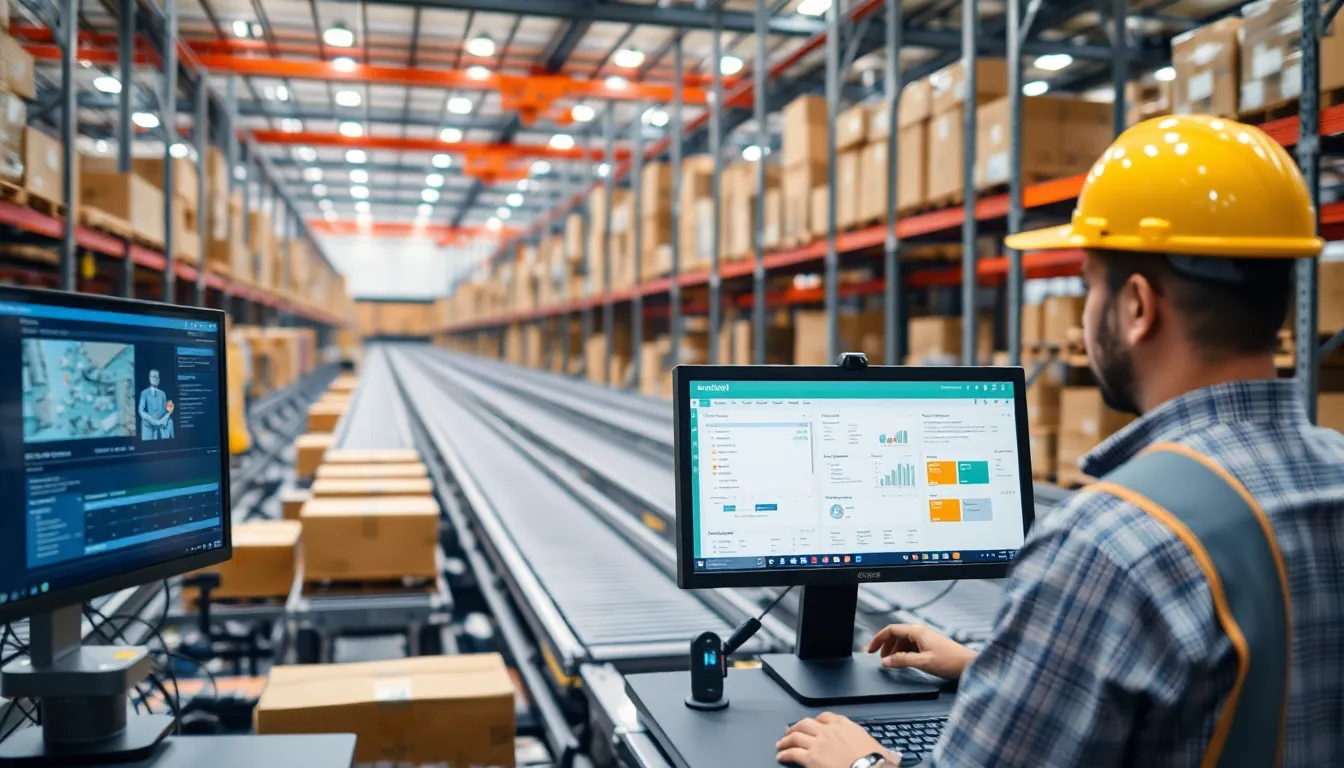In a world where time is money and efficiency reigns supreme, logistics automation is the superhero every business needs. Imagine a realm where packages zip around like they’re on roller skates, and paperwork disappears faster than a magician’s rabbit. With logistics automation, businesses can streamline operations, reduce costs, and keep customers smiling without breaking a sweat.
But it’s not all about speed; it’s also about accuracy. Gone are the days of lost shipments and inventory nightmares. Automation swoops in to save the day, ensuring that every item is tracked and accounted for. So, if you’re tired of playing hide-and-seek with your products and want to transform your logistics game, buckle up. The future of logistics is automated, and it’s ready to take your business to new heights.
Table of Contents
ToggleWhat Is Logistics Automation?
Logistics automation involves the use of technology to improve logistics operations. Such technology simplifies various processes, including order fulfillment, inventory management, and shipment tracking. It encompasses systems like warehouse management, transport management, and robotics.
Using automation reduces manual tasks and enhances speed. Companies find that these systems streamline workflows and minimize human error. For instance, automated inventory tracking prevents stock discrepancies, ensuring accurate stock levels. Similarly, automated scheduling optimizes delivery routes, leading to lower transportation costs.
Data analysis plays a crucial role in logistics automation. Leveraging real-time data allows businesses to make informed decisions, improving efficiency and responsiveness. Predictive analytics helps in forecasting demand, ensuring businesses meet customer needs promptly.
Automation also enhances customer experience. Customers appreciate timely deliveries and accurate tracking updates, which automated systems provide consistently. As a result, streamlined communication with clients fosters trust and loyalty.
In recent years, businesses across sectors have increasingly adopted logistics automation. According to a report by Gartner, over 70% of companies use some form of automation in logistics. Consequently, this trend is shaping the future of the industry, making automation a necessary strategy for competitiveness.
Benefits of Logistics Automation

Logistics automation offers significant advantages that enhance business operations. By implementing automated systems, companies experience a transformation in efficiency and cost management.
Increased Efficiency
Increased efficiency is a primary benefit of logistics automation. Streamlined processes reduce manual tasks, allowing staff to focus on higher-value activities. Automation of order fulfillment and inventory management speeds up operations, minimizing delays. Systems like warehouse management software enable real-time tracking of goods and optimize storage space. Efficiency gains also stem from predictive analytics, which enhance demand forecasting accuracy. As a result, businesses can respond swiftly to customer needs, boosting satisfaction and loyalty.
Cost Reduction
Cost reduction emerges as another major benefit of logistics automation. Automation decreases labor costs by reducing reliance on manual efforts. This technology minimizes errors, which can lead to costly inventory discrepancies or shipment issues. Lower transportation costs result from better route optimization and scheduling automation. A significant finding shows that over 70% of companies adopting logistics automation experience reductions in operational costs. Such savings free up resources for investment in other strategic areas, further enhancing competitiveness in the market.
Common Technologies in Logistics Automation
Logistics automation integrates various technologies that enhance efficiency and streamline operations. Companies increasingly rely on specific systems to optimize workflows.
Warehouse Management Systems
Warehouse management systems (WMS) provide real-time inventory visibility and streamline order fulfillment. By automating storage and retrieval processes, these systems minimize manual tasks and reduce errors. They allow businesses to manage stock levels efficiently, ensuring availability aligns with demand. Over 70% of companies that implement WMS report improved inventory accuracy and increased storage utilization. Enhanced tracking capabilities empower staff to focus on strategic initiatives rather than mundane tasks.
Robotics and AI
Robotics and AI play a crucial role in logistics automation, transforming how warehouses and distribution centers function. Automated guided vehicles (AGVs) transport products, enhancing speed and accuracy. AI algorithms analyze data to optimize operations and forecast demand. With predictive capabilities, companies streamline decision-making processes and improve responsiveness. Implementing robotics can lead to significant reductions in operational costs while increasing efficiency. Ultimately, businesses utilizing robotics and AI enjoy a competitive edge in the logistics sector.
Challenges in Implementing Logistics Automation
Implementation of logistics automation presents several challenges that organizations must navigate. Identifying and addressing these hurdles helps ensure successful adoption.
High Initial Investment
Organizations face significant upfront costs when deploying automation technologies. Investment in systems like Warehouse Management Systems and robotics can require substantial capital. Budget considerations become crucial, as purchasing and integrating new technology often strains financial resources. Furthermore, ongoing maintenance and potential upgrades add to the long-term expenses. Companies participating in automation projects should weigh these costs against potential savings and efficiency gains, making careful financial planning imperative.
Workforce Adaptation
Adapting the workforce to new automated systems poses another challenge. Employees may resist changes due to fear of job displacement or unfamiliarity with technology. Training programs become essential to ease this transition and develop employees’ skills. Successful companies engage their teams in the automation process, fostering a culture of collaboration and innovation. Open communication regarding the benefits of automation can mitigate resistance and gain employee buy-in. Emphasizing how automation can enhance job roles rather than eliminate them helps create a more positive outlook on transition efforts.
Future Trends in Logistics Automation
Emerging trends in logistics automation indicate significant advancements in technology and operational efficiency. Companies increasingly rely on artificial intelligence to enhance predictive analytics capabilities. Robotics are becoming commonplace in warehouses, allowing for faster order fulfillment and improved accuracy.
As demand for real-time data grows, organizations adopt more sophisticated warehouse management systems. New features enable seamless tracking of inventory, reducing the likelihood of discrepancies significantly. Automated guided vehicles streamline logistics by optimizing material handling processes.
Furthermore, integration of Internet of Things devices facilitates better communication between systems. Companies leverage IoT sensors to monitor shipment conditions, ensuring product integrity throughout the supply chain. Enhanced connectivity improves transparency, leading to better trust among stakeholders.
Drones gain traction for last-mile delivery, offering faster service in urban areas. These aircraft provide a unique solution to traffic congestion, making it easier to reach customers promptly. As regulations adapt, broader adoption of drones in logistics is expected.
With sustainability becoming a priority, businesses explore eco-friendly automation solutions. Leveraging electric vehicles reduces carbon footprints, aligning operations with environmental goals. Innovations in packaging technologies also promote sustainability by minimizing waste.
Overall, the logistics industry evolves rapidly through automation and technology. Organizations pursuing these advancements position themselves for future success in an increasingly competitive landscape. Increasing reliance on data-driven decisions shapes smarter logistics operations, ensuring that companies remain agile and responsive to market demands.
Logistics automation is no longer just an option; it’s a necessity for businesses striving to stay competitive. By embracing technology, organizations can streamline operations and enhance efficiency while reducing costs and improving customer satisfaction.
As the industry continues to evolve, the integration of advanced systems and predictive analytics will play a crucial role in shaping logistics strategies. Companies that invest in automation not only gain operational advantages but also foster a culture of innovation and adaptability.
With the right approach, logistics automation can transform challenges into opportunities, paving the way for future success in a rapidly changing landscape.










